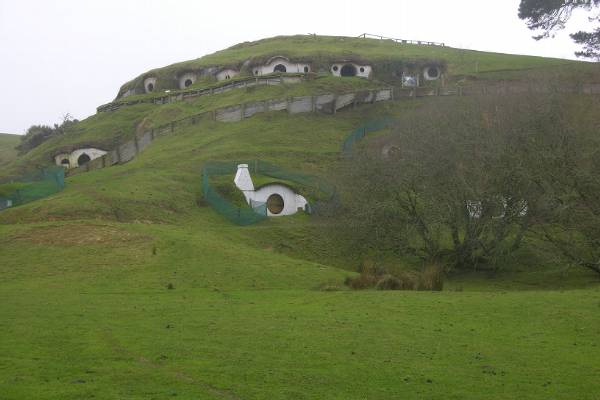< Previous | Next >
We left as early as possible because the hostel was giving me the creeps.
As far as I can tell, there was some sort of big film made in New Zealand recently - the characters have been painted on jumbo jets, all the shops have posters and cardboard cutouts and the films are on display in virtually every video store we've passed. So ee headed straight for Matamata, the home of Hobbiton, for a guided tour round what is left of the film set.
I don't really like it when they say that you can only go somewhere as part of a guided tour, I get a bit stroppy and want to do it on my own, but to their credit the tour operator of the Hobbiton set explained all the restrictions very clearly, and it became obvious why the tour was necessary. The set itself was on private land about 20 minutes' ride out of Matamata and the land owners had set up the tour company. The guide told us a story about the New Line guys turning up at the farm to ask permission to film on their land, and the owner telling them to come back after the rugby had finished. He'd never heard of Tolkein or Lord of the Rings, but he's quite a lot more knowledgeable now.
The farm was idylic, rolling hills, lakes, huge oak and cedar trees and now thousands of sheep too. It was very muddy and threatening to rain, but it actually held of for the 90 minutes of the tour, which was good of it. There were about thirty original hobit-holes built to make Hobbiton, all of which were dressed in painted polystyrene bricks, with glass windows and neatly-planted gardens. The contract to build the set stated that everything would be returned to its original state as soon as filming was finished, and, due to unseasonably wet weather as the demolition started, the removal process was halted and the farm owners managed to get permission to keep the remaining set intact. They are, however, prohibited from doing anything to it to make it resemble the film, as that is a breach of their contact and of copyright laws. I was surprised by all these conditions and by how strict the film company was.
The result is a series of hills adorned with grassy roofs and small white walls with round windows. It's all made of plywood and nothing can be done to make it any more scenic.

The tour explained a lot about the filming of the films and the guide told us stories he'd heard from the land owners. The lengths that the film-makers went to to get the right look were extraordinary - they had their own nursery to grow all the plants for the hobbit gardens, their own polystyrene factory to make all the cladding, and they even chopped down an oak tree from a neighbouring farm and bolted it back together in a different place. Then they stripped all the original leaves off and tied on hundreds of thousand of arificial leaves to give the right colour. Crazy, but kind of cool.
The tour was actually very good, and it made me want to watch the films again. Have to wait until Christmas for that. Or Wellington.
After Matamata we drove to Rotorua, another bland modern town made up of shoping malls and industrial estates. The hostel was huge, but clean and comfy. We decided to spend a few nights here to explore the area a bit. Rotorua is a major geothermal area with hot springs and bubbling mud pools all over the place. It smells of sulphur almost all the time, and there are big clouds of steam everywhere, indicating the hot pools.
It was getting dark, so we found the local cinema to watch Shrek 2 (excellent, especially as a sequel, and a bit in the credits worth waiting for) and went out to a very nice Thai restaurant for supper cos we didn't fancy cooking.
< Previous | Next >
